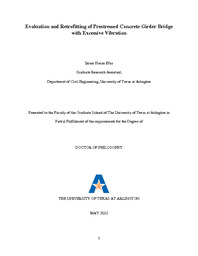
ATTENTION: The works hosted here are being migrated to a new repository that will consolidate resources, improve discoverability, and better show UTA's research impact on the global community. We will update authors as the migration progresses. Please see MavMatrix for more information.
Show simple item record
| dc.contributor.advisor | Yazdani, Nur | |
| dc.creator | Efaz, Ikram Hasan | |
| dc.date.accessioned | 2022-07-14T18:07:56Z | |
| dc.date.available | 2022-07-14T18:07:56Z | |
| dc.date.created | 2021-05 | |
| dc.date.issued | 2021-05-05 | |
| dc.date.submitted | May 2021 | |
| dc.identifier.uri | http://hdl.handle.net/10106/30714 | |
| dc.description.abstract | Vibration of a highway bridges is a serviceability issue according to American Association of State
Highway and Transportation Officials (AASHTO). Though vibration is one of the primary reasons
of bridge deck cracking, AASHTO only has a deflection limit to counterpart vibration which is
not adequate according to many researchers. For instance, SH-75 SB Bridge over Wilson Creek in
McKinney, Texas was observed to have excessive vibration and cracking on the concrete deck. To
evaluate the condition of the bridge, Ground Penetrating Radar (GPR) and Impact Echo (IE) were
used on the deck as Non-Destructive Evaluation (NDE) methods. A diagnostic load test was also
conducted to obtain the load carrying capacity of the deck and the girders. Though GPR showed
satisfactory cover, IE showed severe delamination of the top of the deck prevalent on the top of
the girder lines. The load test additionally revealed partial-composite action between the girders
and the precast panel/cast in place deck system. Moreover, a follow-up load test after a year
confirmed the loss of composite action by revealing similar results to the first load test. A
combined NDE and load testing method was used to load rate the girders and the deck of the bridge
successfully which showed that both deck and girders were able to carry the load. However,
propagation of cracks, potholes and severe vibration on deck should be considered as future
concerns in terms of serviceability and durability.
Ambient vibration testing was also conducted on the SB bridge and on two other bridges with no
vibration issue for comparison. The girders and deck of the SB showed significantly higher lateral
and vertical accelerations than the control bridges. On the other hand, the fundamental frequency
of the SB bridge was very low compared to the literature. The lower natural frequency can be
explained by the reduced stiffness of the girders and the deck-panel system due to the delamination
and partial-composite action.5
A Finite Element Model (FEM) was prepared in ABAQUS CAE using the geometric and material
properties of the SB bridge. The FEM was calibrated based on the load test and vibration test
results so that the model could represent the actual condition of the bridge. Several retrofitting and
stiffening methods were studied in the model to check the effectivity of the retrofitting methods.
Finally, a comparative cost analysis was prepared for these proposed retrofitting methods based
on the Average Low Bid Unit Prices from the Texas Department of Transportation (TxDOT) and
some general recommendations were made for future research. | |
| dc.format.mimetype | application/pdf | |
| dc.language.iso | en_US | |
| dc.subject | Composite action | |
| dc.subject | Vibration of highway bridges | |
| dc.subject | Retrofitting | |
| dc.title | EVALUATION AND RETROFITTING OF PRESTRESSED CONCRETE GIRDER BRIDGE WITH EXCESSIVE VIBRATION | |
| dc.type | Thesis | |
| dc.degree.department | Civil Engineering | |
| dc.degree.name | Doctor of Philosophy in Civil Engineering | |
| dc.date.updated | 2022-07-14T18:07:56Z | |
| thesis.degree.department | Civil Engineering | |
| thesis.degree.grantor | The University of Texas at Arlington | |
| thesis.degree.level | Doctoral | |
| thesis.degree.name | Doctor of Philosophy in Civil Engineering | |
| dc.type.material | text | |
Files in this item
- Name:
- EFAZ-DISSERTATION-2021.pdf
- Size:
- 11.02Mb
- Format:
- PDF
This item appears in the following Collection(s)
Show simple item record


